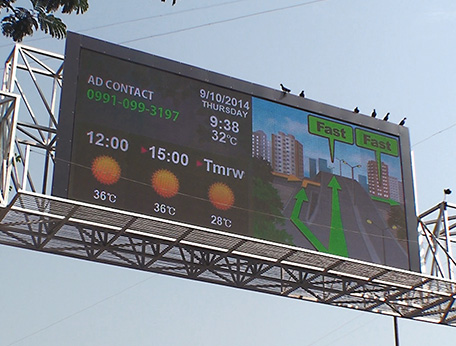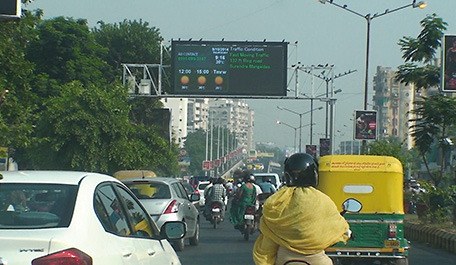Master Techniques, From Japan to the World - 4
Alleviating urban traffic jams with an IT-driver information distribution system
– A trial in Gujarat, India, by a Kyoto-based venture company

A traffic information signboard showing road congestion information and recommended routes. (Photo: Zero-Sum, Ltd.)
India – a country with a population of approximately 1.2 billion, is now undergoing rapid growth. It is a place where the insufficiency of infrastructure such as electricity, railways, and roads is becoming a serious problem. Particularly in urban areas, traffic jams caused by population inflows are becoming increasingly heavy. The Indian government has been working to improve the country's hard infrastructure to address these issues, such as by setting the goal of building 7,000 kilometers of road a year. However, the fact is that these efforts have not kept pace with the rapid increase in the number of vehicles on the road. Moreover, in densely populated urban areas, due to various restrictions relating to land-use, there is a limit to the extent that traffic jams can be alleviated by building roads alone. What India needs is not only the implementation of hard-infrastructure efforts, but also the establishment of a traffic jam alleviation system that can efficiently control the flow of traffic.
A company based in Kyoto, ZERO-SUM, LTD., is trying to establish just such a traffic jam information distribution system in India using their IT capability. Founded in 2004, ZERO-SUM originally focused on the development and distribution of mobile phone systems and content for the Japanese market. However, in 2007, it created a subsidiary, Zero-Sum Wireless Solutions India Private Limited, with the goal of developing its business in India.
President Chikara Kikuchi explained, “Having witnessed for myself the rapid growth in the number of mobile phone users in India, I felt certain that this country would become a gigantic market. That is why we decided to create systems and content by bringing together the local needs of India with the technological capabilities of Japan.” Incidentally, when Zero-Sum Wireless Solutions India was founded, there were around 50 to 60 million mobile phone users in the country. As of 2014, that number has reached approximately 900 million. It is clear that the Indian mobile phone market has expanded with surprising speed.
When Mr. Kikuchi started to visit India frequently after the establishment of his company's subsidiary, he was shocked by terrible traffic jams in urban areas in the country. He felt that the traffic jams were an obstacle to not only his business, but also the Indian economy as a whole, and so he began to think about the possibility of creating a traffic jam alleviation system, applying the technological capabilities of Japan. In the past, Mr. Kikuchi was involved in the development of car navigation systems in Japan. Harnessing the knowledge he had accumulated over the years, he embarked on a JICA Pilot Survey for Disseminating Small and Medium Enterprises Technologies1 in November 2013 with the aim of alleviating traffic jams in Ahmedabad, the largest city in the western Indian state of Gujarat. The counterpart organizations in India are the Ahmedabad Municipal Corporation and the Gujarat State Traffic Police.
The system that has been built for traffic alleviation uses sensors installed on roads, GPS2 installed in taxis, and mobile terminal navigation functions to gather data on such matters as the number of cars on the road and their speed. Compiling these data, the system provides traffic jam information for distribution over mobile data networks to traffic information signs on the roadway and mobile phones. By showing drivers where traffic jams are and encouraging them to take alternate routes, the system promotes the efficient movement of cars and the alleviation of traffic congestion.

One of the four information displays installed in the city through this project. (Photo: Zero-Sum, Ltd.)
“Design and development of the traffic information signboards to be installed along the roadways was done in Japan, and their production was completed in China where the costs were low. We are very strict when it comes to quality control. The problem for us was the local temperature. It is not uncommon for the temperature in Gujarat State to reach close to 50 degrees Celsius. With their original design, the information signs would not function when it got so hot. After a lot of trial and error, we eventually achieved an innovative design that is able to withstand the heat by quadrupling the number of installed cooling fans. I often hear from people that although air conditioners made in other countries tend to stop functioning when the temperature rises, Japanese-made air conditioners do not stop working no matter how hot it gets. As such comments suggest, the level of confidence in Japanese technology is very high, and I believe that we too must uphold that image. So we have been very particular about quality,” commended Mr. Kikuchi.
Mr. Kikuchi reported that he is already hearing of strong interest in the Pilot Survey from the second- and third-largest cities in Gujarat, and from other states as well. “It is gaining a lot of attention as a system that can alleviate traffic jams by making maximum use of already existing infrastructure, even in regions that cannot build new roads. This should also work well in other places troubled by traffic jams. The losses from traffic jams are not minor ones. They can even cause declines in economic efficiency. I am happy that we can use our technological capabilities to help solve this problem.”
*1 Projects that consider ways to promote products and technologies developed by Japan's SMEs and other companies in developing countries through pilot and demonstration activities aimed at making the products and technologies more compatible to local conditions, based on proposals from such companies and other organizations. Projects are funded with up to a total of ¥100 million for a cooperation period of around one to three years.
*2 Global Positioning Systems
<< Previous Page Next Page >>
Main Text | Statictics and Reference Materials | Stories from the field | Master Techniques, From Japan to the World - | ODA Topics
